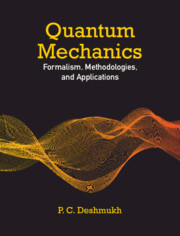Book contents
- Frontmatter
- Dedication
- Contents
- List of Figures
- Foreword
- Preface
- 1 Description of a Physical System
- 2 Path Integral Formulation of Quantum Mechanics
- 3 Probability Tangles and Eigenstates of One-dimensional Potentials
- 4 Angular Momentum
- 5 The Non-relativistic Hydrogen Atom
- 6 Approximation Methods
- 7 The Relativistic Hydrogen Atom
- 8 Quantum Mechanics of Spectral Transitions
- 9 The Many-Electron Atom
- 10 Quantum Collisions
- 11 Introduction to Quantum Information and Quantum Computing
- Appendix A Symmetry of the Hamiltonian
- Appendix B Schrödinger, Heisenberg, and Dirac “Pictures” of Quantum Dynamics
- Appendix C Spherical Harmonics
- Appendix D Occupation Number Formalism Second Quantization
- Appendix E Electron Structure Studies with Qubits
- Index
6 - Approximation Methods
Published online by Cambridge University Press: 14 September 2023
- Frontmatter
- Dedication
- Contents
- List of Figures
- Foreword
- Preface
- 1 Description of a Physical System
- 2 Path Integral Formulation of Quantum Mechanics
- 3 Probability Tangles and Eigenstates of One-dimensional Potentials
- 4 Angular Momentum
- 5 The Non-relativistic Hydrogen Atom
- 6 Approximation Methods
- 7 The Relativistic Hydrogen Atom
- 8 Quantum Mechanics of Spectral Transitions
- 9 The Many-Electron Atom
- 10 Quantum Collisions
- 11 Introduction to Quantum Information and Quantum Computing
- Appendix A Symmetry of the Hamiltonian
- Appendix B Schrödinger, Heisenberg, and Dirac “Pictures” of Quantum Dynamics
- Appendix C Spherical Harmonics
- Appendix D Occupation Number Formalism Second Quantization
- Appendix E Electron Structure Studies with Qubits
- Index
Summary
One of the basic rules of the universe is that nothing is perfect. Perfection simply doesn't exist…..Without imperfection, neither you nor I would exist
—Stephen Hawking (1942–2018)Approximations are made in mathematics, physics, engineering, and life sciences for a variety of reasons such as (a) obtaining an exact solution is not possible and (b) an exact solution is not necessary, subject to a given context. Both of these factors are important in the development of approximations. We have already seen in Chapter 2 that out of the infinite alternative paths accessible to a system due to their entanglement/superposition, the classical path that makes action stationary results from the condition that action is much larger than the PEB constant. When this condition is satisfied, laws of classical physics provide an excellent approximation to quantum mechanics. In Chapter 2, we observed that the interpretation of the wavefunction as probability amplitude became the basis of the path integral formulation of quantum mechanics, in which the propagator's phase is the action. Considering this relationship, it is appropriate to wonder if the Schrödinger equation could have been predicted from classical mechanics, if only the wavefunction (Eq. 6.22, below) was introduced, even just as a definition. In Section 6.1, we demonstrate, in hindsight, how this could have been possible. Of course, historical development of quantum mechanics took place on a different course. We also demonstrate the inverse of this process, viz., how the classical equation of motion is obtainable as an approximation from quantum mechanics in the limit h→0. An approximation scheme often implemented to solve the Schrödinger equation, called the Wentzel–Kramers–Brilloiun–Jeffrey (WKBJ) method, is based on the connections between classical and quantum mechanics. It is introduced in Section 6.1. In Section 6.2, we discuss perturbation methods to obtain approximate solutions to unsolvable problems. Time-independent perturbation methods are discussed in Section 6.2, and time-dependent perturbation methods in Section 6.3. Major non-perturbative approaches to attack complex problems include the adiabatic approximation, the sudden approximation, and the method of variation. These are introduced in Section 6.4.
6.1 Classical Limit of the Schrödinger Equation and the WKBJ Approximation
Readers who are well conversant with the Hamilton–Jacobi (HJ) theory in classical mechanics [1] will be able to skip a significant part of the discussion in this section. It is, however, included here, even if only briefly, for the sake of completeness.
Information
- Type
- Chapter
- Information
- Quantum MechanicsFormalism, Methodologies, and Applications, pp. 270 - 318Publisher: Cambridge University PressPrint publication year: 2024
